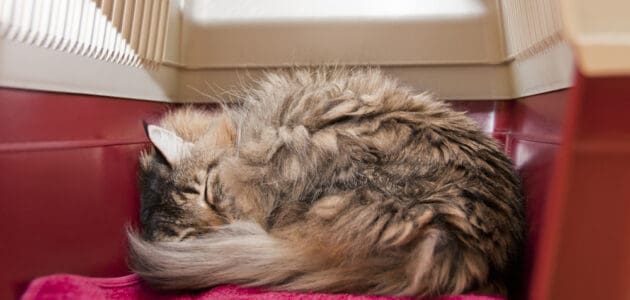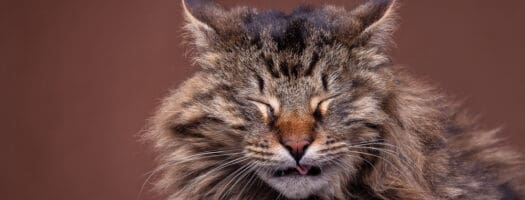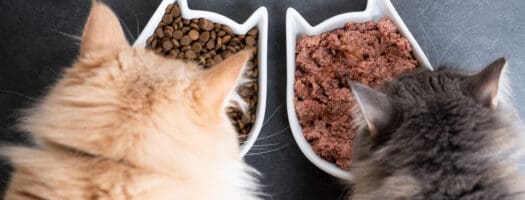How to Sedate a Cat for Travel

It’s no big secret that travel and cats don’t always mix. As creatures of habit, many cats love the constancy of home and the routine that it provides. While some felines can be trained to get used to traveling, most aren’t fond of change and will get stressed easily. Even if they do become accustomed to regular travel, some cats will still express anxiety by meowing, scratching, drooling, or panting.
As a pet owner, the last thing you want is for your poor cat to have a full-blown panic attack while you’re on the go. Thankfully, there are ways to sedate your cat and ease their travel stress. These include calming devices, natural herbs, and ensuring their travel crate is as comfortable as possible. Commercial sedatives can also be safely used, but vets recommend these as a last resort because of the potential side effects.
If you’re about to embark on a road (or air) trip with your feline, below are some of the best ways to sedate your cat for the journey ahead.
Talk to Your Vet
Before you undergo the task of sedating your cat, it’s worth speaking to your vet first. If they know your cat’s temperament, they can also advise on the best means of sedation—whether it’s a prescription or something more natural. Even if you opt for alternative methods, it’s a good idea to acquire a prescription in case the other methods don’t work and your cat decides to freak out mid-journey!
Do a Few Pre-Trip Tests
If you’ve never traveled with your cat before, it’s advisable to do a few test runs to see how they respond. You could get lucky and end up with a Buddha-like feline who snores away and is unaffected by the movement and change of scenery. Alternatively, your cat could be the next Houdini, trying to escape at any given moment while you’re on the move.
Either way, it’s best to test your cat in the car first. If you have time, experiment with some of the sedation methods below to see how your cat responds during the test runs.
Do Not Give Your Cat Human Sleeping Pills
While it may be tempting to give you a cat a bit of your own sleeping pills, this must be avoided. For one thing, a cat’s sleeping cycle is very different from a human’s, and a human sleeping pill can disrupt it.
More importantly, sleeping pills designed for people can be very dangerous for your cat – or even lethal. Even a small dose of human sleeping pills could prove fatal to your cat, so if you choose to go the medical route, be sure to choose something designed for cats instead. We take a detailed look at the most popular medical sedatives below.
Natural Sedation Methods
If you want your cat to be as calm as possible on your travels, there are a variety of natural methods you can try. The benefit of these methods is that they are usually quite harmless and don’t come with an array of nasty side effects.
Calming Collars
Calming collars are fantastic devices for anxious or fearful cats as they emit the same pheromone that mother cats produce to calm their litter of kittens. Calming collars are safe and easy to use, and they are especially good for long-distance car travel. These collars also typically come with other soothing scents such as lavender and chamomile.
Applying the collar is an easy task and requires a simple adjustment around their neck. Once you’ve fitted it, the collar will release a white powder, which activates the pheromones.
While the collar should be safe for most cats, watch out for any unusual behavior while they’re wearing it. Also, if your cat has any skin conditions or allergies, it’s best to check with your vet or do a test to make sure they don’t have an adverse reaction.
ThunderShirt
One of the more novel sedation products on the market is the ThunderShirt. Consisting of a weighted T-shirt-like blanket, the ThunderShirt applies gentle pressure to relieve anxiety.
Intended to mimic the way kittens or infants are swaddled by their mothers, this unique product is a natural way to help your cat feel more at ease. Ideal for traveling and stressful visits to the vet, the Thundershirt is one of the simplest calming methods out there.
Pheromone Wipes & Spray
If your cat isn’t partial to wearing shirts or collars, another option is to purchase a pheromone spray or wipe. These products can be sprayed around the car, inside the carrier, or on any blankets and items that the cat will be using during travel.
Sprays give you more control over the amount of pheromones that your cat is exposed to, and they can work as an emergency method if your kitty becomes suddenly anxious.
Soothing Herbs
Herbs are another way great way to safely sedate a cat. Taking the form of tinctures, dried flowers, or oils, herbs are a natural way of calming your kitty. Below are some of the more popular options to choose from.
Catnip
Catnip is by far the most well-known and popular herb used by cat owners. While catnip generally creates an intense energy boost, this herb can sedate by proxy.
In other words, if you administer the catnip and allow your cat to go crazy for 20 minutes before you leave, they’ll exhaust themselves and will be calmer for the travels ahead. If your cat isn’t terribly anxious to begin with, this method should do the trick.
Valerian
Valerian is known for promoting relaxation and calmness in both cats and people. Used as a remedy for insomnia in the human world, valerian can be an effective remedy for a cat’s anxiety. Bizarrely though, valerian comes from the same family as catnip, so it initially produces the same energetic boost.
However, valerian also produces a sedating effect in some cats afterward, causing them to fall soundly asleep once they’ve gone berserk. If your cat is a bit more fearful and wired, this herb is a better option than catnip.
Chamomile
Chamomile is another popular herb in the human world and is often consumed as a calming tea. While chamomile produces the same relaxing effects in cats, they need to be exposed to the dry flowers for it to work. A good way to do this is to add the flowers to a tube collar so that your kitty doesn’t ingest them. Or you could find ways to store the flowers near their blanket or crate for additional exposure.
Hops
Hops are another great herb for promoting calm and relaxation in a cat. Again, it’s best to expose your cat to the dried flowers, so while beer may be the first thing on your mind, it’s best to add these to a tube collar or find ways to stash it near their blanket.
Rescue Remedy
Flower essences have long been used by humans to relieve anxiety and stress. The great news is that these therapies also work well on cats. Providing almost instant relief due to its liquid formula, Rescue Remedy is fantastic as an emergency aid or as an ongoing treatment for a fearful cat on the go. There are also alcohol-free versions if you’re concerned about kitty’s reactions.
Medical Sedatives
If your cat requires something stronger than the methods above, a medical sedative is another solution. While they sometimes come with side effects, these drugs can be used safely in moderation.
Note that some sedatives require prescriptions, so it’s best to speak to your vet about the best and safest options. Below are some of the more common types that are used.
Benzodiazepines
Benzodiazepines are a class of drugs that require a prescription from your vet. Benzos act as muscle relaxants and are often used for conditions like anxiety. These drugs work by increasing gamma-aminobutyric acid (GABA), a neurotransmitter in the brain that causes sleepiness and relaxation. While they are safe to use, cats require a much lower dosage than a human.
Benzos can be administered orally via tablets or in liquid form. It can also be injected on-site at a vet’s office. However, there are potential side effects to be aware of, such as aggression, agitation, vomiting, and respiratory depression.
Tip: If your kitty is pregnant or has liver or kidney problems, this drug isn’t safe to use.
Chlorpheniramine
Chlorpheniramine is an over-the-counter drug commonly used for colds and allergies. While it is also used to treat allergies in cats, it is a useful sedative because the biggest side effect of this medication is drowsiness. However, this drug can counteract other drugs your cat might be on, so again, make sure you speak to your vet to make sure it’s safe.
Chlorpheniramine can be administered orally in tablet or liquid form. Aside from drowsiness, other potential side effects of this drug include diarrhea, vomiting, lack of appetite, and dry mouth.
Tip: This medication can take a couple of hours to take effect, so make sure you give it to your cat well ahead of your travels.
Diphenhydramine (Benadryl)
Otherwise known as Benadryl, diphenhydramine is another over-the-counter medication. As the most recommended form of sedative for cats, Benadryl performs a dual function of inducing relaxation while treating motion sickness. If your cat is anxious and gets nauseous while traveling, this is an excellent option. Like the other drugs on this list, the dosage is much smaller (about 1 mg per pound up to three times per day).
The best way to administer Benadryl is with a pill or a liquid syringe. However, bear in mind that your cat might refuse it due to the strong taste! You can disguise it in food or go to a compounding pharmacy that will flavor the Benadryl with a fish or chicken flavor instead.
This drug is most effective if you start 24 hours before your travels. The potential side effects are harmless, but they include lethargy, dry mouth, and urinary retention.
Tip: Cats that have glaucoma, high blood pressure, prostate problems, or difficulty urinating should not take diphenhydramine.
Gabapentin
Gabapentin is also available over the counter and is an inexpensive way to sedate your cat for travel. Primarily used to treat seizures and neuropathic pain in humans, this drug is also useful as an anti-anxiety drug for pets. One of the benefits of this medication is its mild taste. Unlike Benadryl, your cat should barely notice the gabapentin if you add it to their dinner.
In terms of dosage, the recommended amount is 65mg for an average cat and 85 mg for larger cats. Sedation is quite strong, though, so you should adjust it depending on the sensitivity and size of your kitty.
Be sure to administer gabapentin at least 2 hours before travel as it takes some time to take effect. Potential side effects include vomiting and a rise in salivation.
Tip: This drug lasts for about 8 hours, which makes it an ideal treatment for long journeys. However, you should seek alternatives if you only want your cat to be dozy for a few hours.
SARI
Serotonin antagonist reuptake inhibitors (SARI) are a class of drugs used to treat anxiety in both cats and dogs. It is also used to sedate cats before stressful situations such as travel or visits to the vet.
Dosages range from 10mg to 30m depending on the size of your cat. It also takes effect in less than an hour, so you don’t need to worry about a long wait time if you’re in a hurry. Another thing to bear in mind is that it takes 12 hours for the drug to leave your cat’s system. This can be beneficial or detrimental, depending on how long you want your kitty to be sedated.
Tip: While this drug is generally safe to use, in rare cases, it can cause cardiac arrest. Therefore, we strongly suggest you speak to your vet first to make sure it’s safe for your particular cat. Other less harmful side effects include short-term lethargy and vomiting.
Clonidine
Clonidine is used for pain management and as a muscle relaxant for cats and dogs. Known as a central alpha 2 adrenergic agonist, clonidine works by stimulating receptors in the brain that control the heart rate and central nervous system. Clonidine is only available by prescription, though, so you’ll need to see your vet first.
One of the benefits of this drug is that it has milder effects, so you don’t need to worry about your cat being too doped up. Its potential side effects are also milder and may include dry mouth, ataxia, and constipation. The average dose of clonidine for a cat is between 0.05 mg to 0.1 mg.
Tip: Clonidine takes about 3 hours to take effect, so you’ll need to administer it well ahead of your travels.
Making Travel Safe and Comfortable
Aside from natural and commercial sedatives, it’s also important to make the journey as comfortable as possible for your feline. There are a few things you can do ahead of time to make sure your cat has the most relaxing travel experience possible.
Pre-Trip
Ensuring that your cat travels on an empty stomach can help prevent motion sickness, particularly if you’re driving. Other things that can make them more comfortable are to lay down absorbent pads in case they need to urinate or defecate on the journey.
Cats are clean creatures and will want some version of a litter tray. You could also try to use up your cat’s energy with play and running around the house before you head out. This will help them feel sleepier and more relaxed while you’re traveling.
Car Travel
If you’re traveling by car, make sure your cat’s carrier is big enough to stand up in, but not so vacuous that they feel exposed. Another tip is to place a thin, dark cloth over their carrier or sleeping area. This will create a mini-sanctuary or at least a place where they can feel safely hidden away. Make sure the cloth is thin to enable clear ventilation.
Other things you should do is pack water and snacks to keep your cat comfortable and fed. An emergency kit is also an excellent idea as they may experience nausea or be more stressed than expected.
Things to have in an emergency pack include calming herbs and sedatives, ointments (for potential itching), and bandages. Include a leash in there, too, as an excited or anxious cat may do well with a short walk to calm their nerves.
Flying
If you’re flying by plane, however, it will be more difficult to ensure your cat feels secure. Your best bet here is to ensure that their carrier is as comfortable as possible. Sedation will also likely be a must, especially if your cat is prone to stress or anxiety.
In some cases, it’s possible to book a seat next to you on the plane so that your cat doesn’t have to travel in the pet area. While it’s an expensive option, you may be saving your kitty from a traumatic flight.
Final Thoughts
Traveling with an anxious cat can be difficult, but it can also be made easier with planning and by implementing some of the tips above. We recommend doing a few test runs with the natural sedation methods first to see how your cat fares.
If those don’t work, visit your vet to discuss other options such as drugs or tranquilizers. While these should only be used as a last resort, they can be highly effective if you’ve got a particularly fearful feline. Good luck and enjoy your travels (with your cat)!




